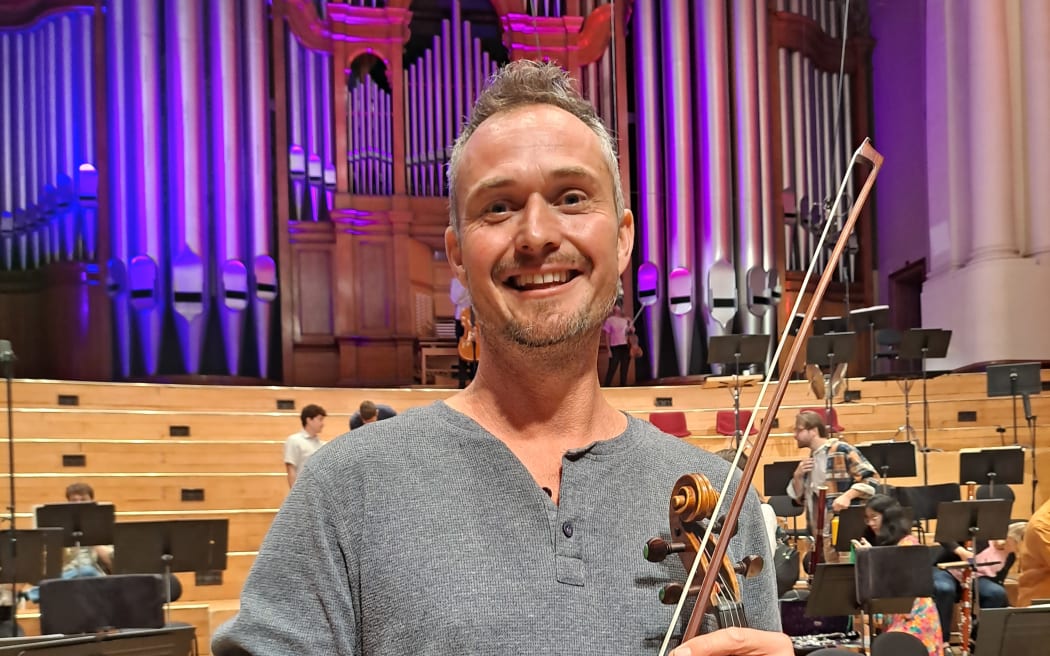
Robert Ashworth Photo: Tim Dodd/RNZ
The Auckland Philharmonia's Principal viola Robert Ashworth stars in Berlioz's hybrid symphony-concerto-tone poem 'Harold in Italy' and Giordano Bellincampi conducts in a programme that also includes Italian inspired works by Schubert and Mendelssohn.
SCHUBERT: Overture in C In The Italian Style
This overture of Schubert’s is from a pair of such works knocked out in 1817 when the composer was just 21. Both were labelled ‘Italian’ (though not by the composer himself), tipping a nod to Rossini whose operas were considered by many to be the antagonist to German opera in a stylistic ‘war’.
Critics praised the ‘youthful fire’ evident in the overtures when performed early in 1818.
MENDELSSOHN: Symphony No 4 in A, Italian
The breezy joy that opens Mendelssohn’s Italian Symphony and the ease of its conception belies the struggle the young composer had shaping the work to his satisfaction. He claimed it gave him "some of the bitterest moments I have ever endured."
Commissioned by the London Philharmonic Society, its premiere took place in the English capital in 1833. The m.o. of the Philharmonic Society was to have the conductor ‘lead’ from the piano at each movement’s start, with the ‘leader’ of the orchestra then keeping tempo. Mendelssohn, however, was not prepared to relinquish control and conducted throughout using a baton. The performance was a hit with the crowd which demanded a repeat of the second movement.
Mendelssohn’s dear friend Ignaz Moscheles recounted "On the 13th of May Mendelssohn was the jewel of the concert, presenting his wonderful A Major symphony for the first time, to thunderous applause."
However, Mendelssohn then subjected the symphony to seemingly endless revisions and his discontent was evident in his refusal to have it published. Good enough for the British, it was in fact never performed in Germany in the composer's lifetime.
All of this was still to come in 1830 when he began his tour of Italy that inspired the work. He noted on his arrival: "I have once more begun to compose with fresh vigour, and the Italian symphony makes rapid progress; it will be the happiest piece I have ever written, especially the last movement."
He observed: "The whole country had such a festive air that I felt as if I were a young prince making his entry."
Despite his doubts, the Italian Symphony slipped happily into the orchestral cannon when it was finally published four years after his death with none of the many sketched out revisions Mendelssohn left inserted into the piece.
BERLIOZ: Harold In Italy
Harold in Italy began as a piece written for the extraordinary violin virtuoso Paganini who in 1834 requested something to showcase a Stradivarius viola he had obtained.
But their conceptions of the work’s form differed leading Paganini to reject it based on a draft of the first movement where he saw that there were too many rests in his part. The two parted company but Berlioz continued with the work and finished it.
Paganini’s connection to the work had one more theatrical flourish. In 1838, Paganini heard it performed for the first time. He dragged Berlioz back onstage after the performance and, contrite, knelt to kiss his hand.
In four movements, Harold in Italy fuses the inspiration of Byron’s poem Childe Harold's Pilgrimage about a wandering melancholic searching for meaning in Italy, with the composer’s own memories of his time in that country after winning the Prix de Rome following multiple attempts.
The four movements each come with an evocative title:
I. Harold in the mountains, scenes of melancholy, happiness and joy
II. March of pilgrims singing the evening prayer;
III. Serenade of an Abruzzian mountaineer to his sweetheart;
IV. Brigands’ Orgy.
PAGANINI: Caprice Op 1 No 13, 'The Devil's Laugh'
An encore played by Robert Ashworth in honour of the man who refused to play the premiere of Harold in Italy but then regretted his decision and was gracious enough to publicly acknowledge that to Berlioz.
Recorded by RNZ Concert in Auckland Town Hall, 29 February 2024
Producer: Tim Dodd
Engineer: Adrian Hollay

